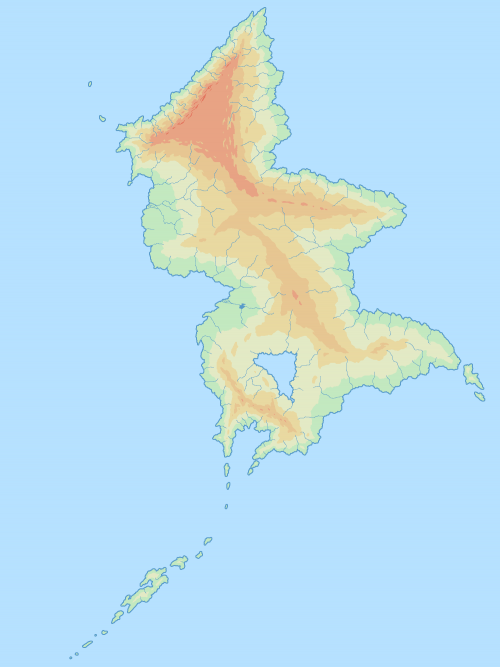D'ekaš
D'ekaš is the most technologically developed of the Novan continents, and where the focus of the Novan conworlding project is. The lands of D'ekaš independently gave birth to two major civilizations, and in the present day is dominated by the Išyaɸa Empire in the west. The south-east on the other hand is a collection of squabbling states that bear descent from the legendary Affalhaq Civilization, though other independent polities exist throughout the continent.
Contents
Etymology
The term D'ekaš is the Išyaɸan word for the continent. It itself is descended from ...
Geology and Geography
Geology
The bulk of the D'ekaš landmass is composed of the D'ekaš plate. Historically this plate moved eastward, colliding with the paleo-Elephants head. This collision is responsible for the large but eroded range that spans the middle of D'ekaš. Ultimately, this plate began moving west, resulting in its current position.
Northern D'ekaš is formed through the collision of three plates: the D'ekaš plate, the North plate and the Northeastern plate. The continental nature of these plates has created a large fold-type mountain range in the north, known as the placeholder mountains. The northeastern plate and north plate have sutured and geologic activity slowed. However, the oceanic portion of the northeast plate continues to subduct underneath the D'ekaš plate.
In the south, the small oceanic placeholder plate is slowly subducting underneath the D'ekaš plate, Atlingi plate, and placeholder plate. This action is responsible for the creation of the prong formation in the south. Simultaneously, the Atlingi plate is slowly subducting beneath the placeholder plate. This action has created the volcanic Atlingi arc. The entire region at large is heavily volcanic and prone to seismic activity.
Geography
As a whole, D'ekaš is a extremely mountainous continent. From the north to south, mountains dominate the land, and consequently the continent has a river-rich hydrography. A few degrees north of the equator, a large endorheic basin is responsible for the placeholder sea. Theres some handwavery here where, despite the large amounts of rainfall characteristic of such an equatorial region, the water level of the sea largely remains constant.
There are two major plains regions, both on the west coast of D'ekaš. The closest to the equator, placeholder, is in fact one large desert, and poses a major obstacle to any who wish to traverse its sands. A few rivers make their way through the area, notably the placeholder river, which flows through Lake Gigashad before turning into a delta, and is flanked by lush greenery fed by its waters. North of this is the largely Mediterranean climate placeholder plain. A massive river system flows through here into the ocean, and regular floods at its delta provide rich soils for agriculture.
North of there is the heavily forested placeholder coast, which lie northwest of the placeholder mountains. This dominating feature covers nearly a fifth of the continent's landmass. Forests dominate the east and southeast of the mountains, surrounding the placeholder range that branches off the placeholders. South of here is the placeholder valley, which is itself north of the tropical placeholder peninsula.
Climate
D'ekaš stretches from 15°S to approximately 64°N. Indeed, if the southern most point in the Atlingi arc is included, D'ekaš extends all the way down to about 39°S. This wide range of latitudes gives D'ekaš many varying climates within its shores. Perhaps most important are the placeholder rainforest zone and the western Mediterranean zone, which each gave birth to civilization within their unique contexts.
Flora and Fauna
History
D'ekaš was initially peopled some 35 thousand years ago as seaworthy peoples navigated the Atlingi arc and reached the continent. Some 15 thousand years later, a subsequent wave of migrants again made the same voyage. This is reflected in the racial make up of the continent, where the southern tropical band and the Atlingi islands are comprised of dark skinned peoples with amber to pale green eyes. In contrast, the inhabitants of the norther two thirds of D'ekaš, as well as the easternmost isles, have a striking change in skin colour that does not reflect a gradual gradient as would be expected of the climactic variation. Northern D'ekašans are instead olive to pale skinned, but uniformly brown eyed. This divide is reflected linguistically as well, where all speakers of northern languages are of the Nothern D'ekašan race and all speakers of southern languages are of the Southern D'ekašan race. The sole exception are the Salt Sea languages, where likely through a historical process of pastoralist expansion and assimilation, both races are represented in the language family.
Languages
The linguistic diversity of D'ekaš is astounding. From its northern tip to the Atlingi islands, a total of 25 language families exist. Perhaps the most important of these families are the Affalhaqic, Deltic, and Salt Sea Languages.
